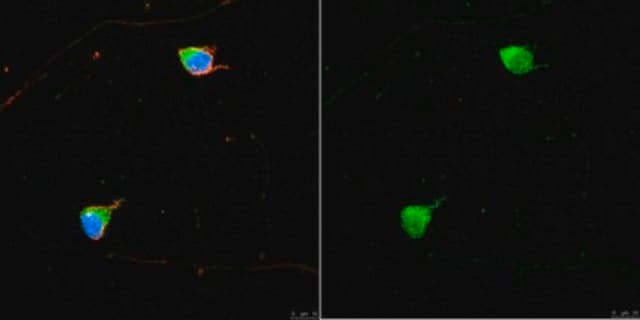MAB1572
Anti-Parvalbumin Antibody
ascites fluid, clone PARV-19, Chemicon®
Synonym(s):
Anti-D22S749
About This Item
Recommended Products
biological source
mouse
Quality Level
antibody form
ascites fluid
antibody product type
primary antibodies
clone
PARV-19, monoclonal
species reactivity
feline, rabbit, goat, frog, fish, human, pig, bovine, rat, mouse, canine
manufacturer/tradename
Chemicon®
technique(s)
immunocytochemistry: suitable
immunohistochemistry: suitable (paraffin)
western blot: suitable
isotype
IgG1
NCBI accession no.
UniProt accession no.
shipped in
dry ice
target post-translational modification
unmodified
Gene Information
human ... PVALB(5816)
General description
Specificity
Immunogen
Application
A previous lot was used by indirect immunoperoxidase at 1:1,000-1:2,000 dilution. The antibody works on formalin fixed, paraffin embedded tissue sections of rat cerebellum from a previous lot. Fixation does not appear to affect MAB1572’s ability to detect parvalbumin.
Immunocytochemistry:
A previous lot of this antibody was used on cultured neurons.
Optimal working dilutions must be determined by the end user.
Neuroscience
Signaling Neuroscience
Quality
Western Blot Analysis:
1:1000 dilution of this lot detected Parvalbumin on 10 μg of mouse brain lysate.
Target description
Physical form
Storage and Stability
Analysis Note
Brain tissue, Cultured neurons
Other Notes
Legal Information
Disclaimer
Not finding the right product?
Try our Product Selector Tool.
recommended
Storage Class Code
12 - Non Combustible Liquids
WGK
nwg
Flash Point(F)
Not applicable
Flash Point(C)
Not applicable
Certificates of Analysis (COA)
Search for Certificates of Analysis (COA) by entering the products Lot/Batch Number. Lot and Batch Numbers can be found on a product’s label following the words ‘Lot’ or ‘Batch’.
Already Own This Product?
Find documentation for the products that you have recently purchased in the Document Library.
Customers Also Viewed
Our team of scientists has experience in all areas of research including Life Science, Material Science, Chemical Synthesis, Chromatography, Analytical and many others.
Contact Technical Service











